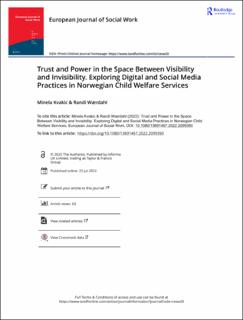Trust and Power in the Space Between Visibility and Invisibility. Exploring Digital and Social Media Practices in Norwegian Child Welfare Services
Peer reviewed, Journal article
Published version
Permanent lenke
https://hdl.handle.net/11250/3022075Utgivelsesdato
2022-07-22Metadata
Vis full innførselSamlinger
- Publikasjoner fra Cristin [3191]
- SAM - Institutt for sosialfag [464]
Originalversjon
https://doi.org/10.1080/13691457.2022.2099350Sammendrag
In this article, we explore how caseworkers in the Norwegian Child Welfare Services and their clients use digital and social media in information sharing. By applying Foucault’s description of Bentham’s Panopticon as an analytical tool, we show how caseworkers’ use of digital and social media without the client’s knowledge, while making themselves invisible, contribute to increase the power asymmetry of a professional–client relationship. The clients, on the other hand, have less possibilities of making themselves invisible. If they discover that caseworkers have invaded their private information, this is experienced as a breach of trust. While some studies discuss the equalising potential of using digital and social media in welfare communication, this study reveals some of the pitfalls in using these medias for communication and information exchange. Regardless of the type of media in question, their use becomes vital for visibility, trust and power. Our findings underscore that it is not only the digital tools that needs regulation. Regulations should address the participation of clients in deciding on communication tools and the all-important openness and non-covert practices necessary to build and maintain trusting relationships between caseworkers and clients. I denne artikkelen utforsker vi hvordan ansatte og tjenestemottakere i det norske barnevernet bruker digitale og sosiale medier i informasjonsutveksling. Vi anvender Foucaults beskrivelse av Benthams Panoptikon som et analytisk verktøy for å vise til hvordan barnevernsansattes bruk av digitale og sosiale medier uten tjenestemottakeres samtykke øker maktasymmetrien i en profesjonell-klient relasjon. Vår studie viser hvordan barnevernsansatte gjør sin egen tilstedeværelse på digitale og sosiale medier usynlig, og hvordan slik praksis kan øke maktasymmetrien mellom profesjonelle og klienter ytterligere. Klienten derimot, har færre muligheter til å gjøre seg selv usynlig. Hvis klienten oppdager at den profesjonelle invaderer deres private informasjon, kan dette oppfattes som et tillitsbrudd. Mens noen studier viser til digitale og sosiale mediers potensiale for utjevning av makt i møte med det offentlige, viser vår studie noen av fallgruvene når slike medier anvendes til kommunikasjon og informasjonsutveksling. Våre funn understreker at det ikke er kun de digitale verktøyene i seg selv som trenger regulering. Reguleringer bør adressere viktigheten av åpenhet og klienters medvirkning i valg av digitale verktøy til kommunikasjon, for å tilrettelegge for etablering og opprettholdelse av tillit i klienters møte med det offentlige.

